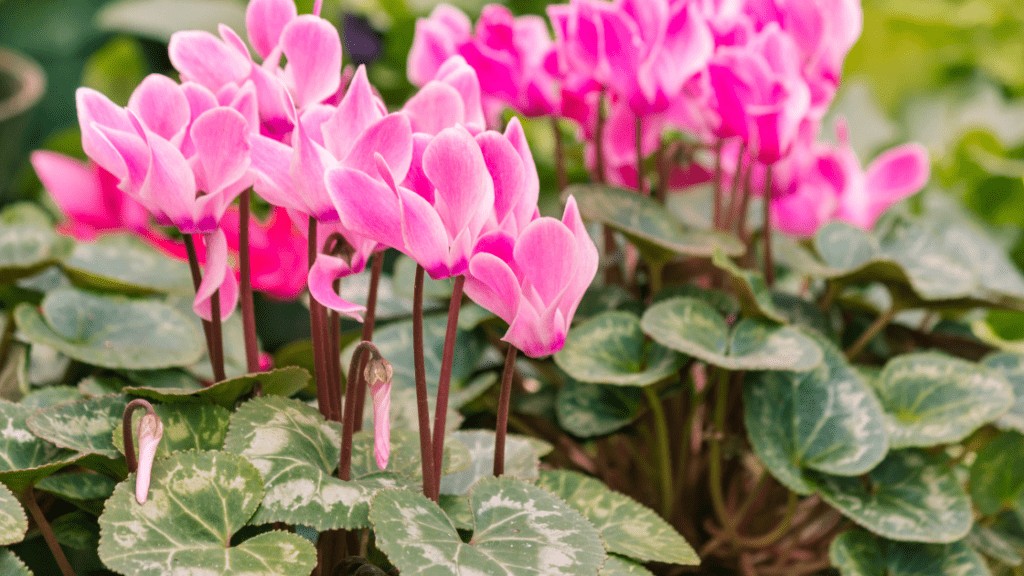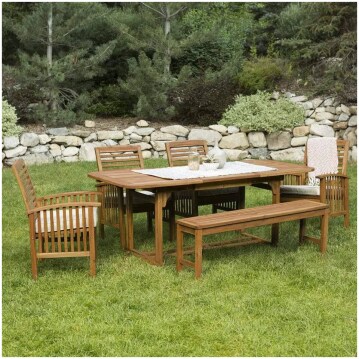
Cyclamens are one of the most commonly grown indoor potted flowering plants – they are very easy to take care of and aren’t demanding.
They are somewhat unique in that they flower during the colder months – from autumn throughout early spring. This makes them perfect for indoor cultivation, and when properly cared for, they will provide you with long-lasting, colorful and fragrant flowers during the winter.
In this article, we’ll explore in detail the optimum growing conditions of cyclamens, how to propagate them and will give you simple solutions to the most common problems you may encounter when growing them indoors.
Browse our Affiliate Products
Description, Common Names and Different Species
Cyclamens are members of the primrose family – a family that contains more than two thousand different species, most of which are low-growing perennial plants, but some of which are large woody shrubs.
Compared to most other perennial flowering plants, the annual growing cycle of cyclamens is almost reversed – in their natural habitat, they emerge from the ground around the end of the summer, bloom during the winter and go into dormancy soon after.
This behavior is common in other plants originating in the Mediterranean region – the Mediterranean climate caries no risk of frost, but the summers are very hot and dry, making it difficult for low-growing, non-succulent plants to extract water from the dry soil.
At the start of the summer, cyclamens transfer most of the nutrition from their leaves into their roots and wait for the temperatures to drop again before they start re-growing new foliage.
Cyclamen seeds also start sprouting at lower temperatures, right around mid-autumn.
Common Names
Cyclamens are one of few plants which are called by their genus name and don’t have other very well-known common names. Although there are almost a dozen different common names for cyclamens, most of them are outdated or not frequently used. ‘Sowbread’ and ‘Alpine lily’ are two examples.
Different Species
As we already mentioned, the name cyclamen actually refers to a genus and not a single species.
There are about two dozen different species of cyclamen, but most of them look very similar, with only slight visual differences in the shape and color of their flowers and the patterns of their leaves.
However, different species have different frost tolerances.

Cyclamen hederifolium (known as the ‘Ivy-leaved cyclamen’) for example is cold hardy down to -4F (-20C), but about 80% of all the other cyclamen species don’t tolerate frost at all – they come from the Mediterranean region, where the winter temperatures don’t drop below 45F (7C).
How Big Do Cyclamens Get?
Cyclamens are low-growing plants that don’t reach a height of more than around 9 inches. This includes the flower and its stem, which is the tallest part of the plant.
The potted cyclamen plants you see sold in supermarkets are mature, full-size plants and they won’t grow in size if planted outdoors.
How to Grow and Care For Cyclamen Plants
Cyclamens are easy to care for, as long as you provide them with plenty of indirect sunlight and don’t overwater them. Let’s take a closer look at the specific growth requirements and how to provide them:
Do They Grow Better Indoors or Outdoors and How Hardy Are They?

Cyclamens are best planted indoors – they are small, low-growing plants that produce a relatively low-number of small flowers, making other flowering plants(like primulas) much more suitable for an outdoor garden.
Most species are very cold-intolerant and will survive winter only in USDA zones 9-11.
Another factor that makes them unsuitable for planting in gardens is that their dormancy period is during the summer.
Exceptions for outdoor cultivation are covered areas, patios and closed balconies with good lighting. Even if grown outdoors, cyclamens are almost always best planted in potting containers and not in a garden bed.
How Much Light Do They Need
Much like many other members of the primrose family, in their natural habitat, cyclamens grow in shaded forest areas.
They don’t do well in direct sunlight and if you’re going to be placing them on the windowsill of a south-facing window, it’s best to use a shade cloth or a thin white curtain to filter the sunlight.
Part of the reason why cyclamens dislike direct sunlight is because they require a relatively low soil moisture, which is very difficult to maintain in a potting container when the plant is placed in the scorching rays of the direct sun.
To prevent wilting and sunburn in this scenario, most people will tend to water the plant excessively, which often deprives the roots of oxygen and leads to rotting, ultimately killing the plant.
Just like growing terrariums indoors, all plants need a certain about of lighting. This article should answer most lighting question when growing indoor. Outdoorgardenaccessories.com/How to Properly Light a Terrarium: Artificial vs. Natural Lighting
What Type of Soil Is Required?
Cyclamens grow well in most general purpose potting mixes.
They require a slightly acidic, rich and well-draining soil, which is what most indoor plants prefer as well. Any soil that is rich in compost will work well.
For more information about soils, check out our article by clicking on the link. Outdoorgardenaccessories.com/ What Are The BEST Potting Soils for Every Type of Plant?
Feeding and Fertilization
Feeding your cyclamen plants is highly recommended – most potted cyclamens are planted in small pots that quickly get depleted of nutrients.
The plant has tuberous roots that store nutrients, so it may grow well even in depleted soil, but eventually it will start flowering much less and growing more slowly.
Any houseplant fertilizer will work well and balanced ratios like 10-10-10 are often recommended.
Make sure to alternate soluble fertilizer with clean water to avoid solute buildup in the soil which can quickly damage the roots.
Optimum Watering Frequency
Cyclamens have water requirements that are very similar to most other low-growing potted plants – water when the top of the soil starts drying up and avoid waterlogging.
Look for any signs of wilting, which may be caused both by underwatering and overwatering. Cyclamens can be watered from the bottom of the pot, through the tray – this works great, because it leaves the top of the soil relatively dry and lets the roots absorb oxygen.
It also prevents wetting of the stems too much, which can lead to fungal or bacterial rot. However, it may be more difficult to determine the optimum watering amount when you’re bottom watering.
Is Repotting Ever Necessary?
For long-term growing of cyclamen plants, you should repot every 2 to 3 years.
This is done to provide more room for the plant to grow and to replace most of the old, depleted soil with fresh one. Repotting is done by lifting the tuber of the plant and removing as much of the oil soil as you can without damaging the root hairs.
The tuber is then placed in a potting container with some soil in the bottom and soil is poured around the tuber. Generous watering is recommended after repotting to eliminate any air pockets and prevent dehydration of the root. Repotting is a great opportunity for propagation by root division.
Also check out our pot article explaining all about the different type of pot and their uses. Outdoorgardenaccessories.com/What is the perfect pot for my plants?
Propagation
Cyclamen are easy to propagate by root division – they have roots similar to potatoes, which can be divided in multiple parts with a sharp knife, or by manually breaking them apart.
This process doesn’t require much explanation and involves digging up the root, cleaning it, dividing it into as many pieces as you like and planting those pieces back into potting soil. The more you divide the root and the more cuts you perform, the higher the chance of failure – the cut surfaces of the roots may start rotting in the soil.
Propagating cyclamen from seed is another option that is more rarely used, but may be much more practical for many people.
- After pollinating the cyclamen flowers with a dry paintbrush.
- Wait for the seed pods to form and mature.
- Once they start drying up, they are ready to collect.
- The seeds can then be planted in regular soil and germinated.
The best temperature for seed germination is low – around 60F( 15C), which is easy to achieve by placing the trays near a cold window during the winter. Seeds germinate best in the dark. Cyclamen plants grown from seeds will start flowering in about 8 months – the start of the next winter season.
For more information check out this video explaining all about cyclamen
When Do Cyclamens Bloom?

Cyclamens flower during the autumn, winter and early spring.
Different species, however, may have a somewhat different flowering behavior and many cultivars are crosses between different species. Because cyclamens are cultivated indoors and are removed from their natural habitat, they may flower at random times and not necessarily during the winter.
The blooming of cyclamens is followed by a rest period, which may not necessarily coincide accurately with the summer season in your geographical area. The rest period will last two to three months, after which the plant will start going into its
growth phase again – it will start sprouting new leaves and will eventually flower again.
What To Do After Blooming?
After blooming, cyclamen plants may look like they are dying – their leaves will start yellowing.
In fact, this doesn’t mean that the plant is dying and instead signals the arrival of the resting period. The plant starts transporting all of the nitrogen from its leaves into the root – the same process that occurs in deciduous trees every autumn.
Unlike most plants which rest during the winter, the rest period of the cyclamen is relatively short and may be over in as little as a month or two. You can use that time to repot the root or divide it for propagation. Once the leaves start dying and the plant starts entering dormancy, stop watering it.
Common Problems You May Encounter
Cyclamens aren’t prone to problems, unless you start overwatering them and creating a suitable, wet environment in which fungal pathogens can thrive.
Leaf spots and bacterial rot may affect all parts of the plant and are best prevented by avoiding stagnant water droplets from sitting on the stalks or the leaves of the plant.
This is part of the reason why cyclamens are best watered from the bottom through the tray of the pot. Apart from pathogens that may awaken in high-humidity conditions, the plant may also get infected by a number of different viral pathogens for which there is no cure – if that happens, you may still attempt to re-grow the plant by carefully washing and replanting its tuber.
Final Thoughts
Cyclamens are a great indoor flowering plant – with some basic care and light fertilization they will flower nicely during the colder months. Don’t throw them away after they’ve finished flowering if they appear to be dying – the plant is simply moving
nutrients from its leaves to its root and preparing for dormancy. The dormancy in cyclamen plants is very short and can be over in as little as 2 months. Most of the problems you may experience when growing cyclamens will come from overwatering – the plant is very prone to root root caused by drowning and you should avoid getting water on the leaves and stems of the plant.









